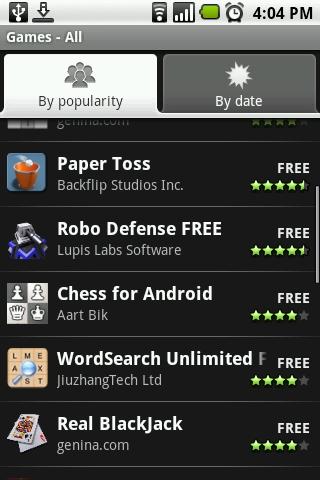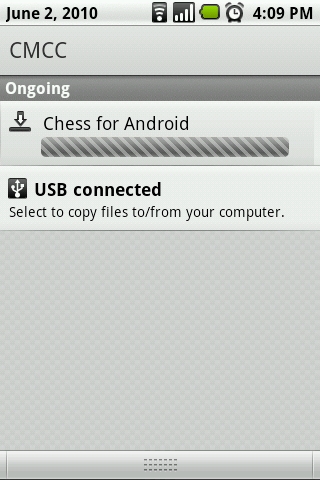“Good programmers write solid code, while great programmers reuse the code of good programmers”
— W. Jason Gilmore, the author of “Beginning PHP and MySQL”
In Android Platform, it supports some ways to download files from URLs via HttpURLConnection or HttpClient, or DownloadProvider.When you write an android programm with Eclipse, try to import:
import android.provider.DownloadsThe Eclipse gives a red error prompting and complains:
The import android.provider.Downloads cannot be resolvedOops…
The download manager is not part of the public SDK, and there are no relational API description in Android developers Reference.Comment in sources frameworks/base/core/java/android/provider/Downloads.java, says: “For 1.0 the download manager can’t deal with abuse from untrusted apps, so this API is hidden.” Refer to the document description from: packages/providers/DownloadProvider/docs/index.html. we Know that Browser / Gmail / Market / Updater depend on the download manager. Yes, show some screenshots in the market:
We maybe can’t compile with Eclipse, but we can write an Android.mk makefile, use mmm to do it.
DownloadProvider is very easy to use.First, declare permission in AndroidManifest.xml:
<uses-permission
android:name="android.permission.INTERNET"
>
</uses-permission>
<uses-permission
android:name="android.permission.ACCESS_DOWNLOAD_MANAGER"
>
</uses-permission>And then just need to fill some field values:
ContentValues values = new ContentValues();
String url = "https://blog.lytsing.org/wp-content/uploads/2010/06/android_downloadprovider_market.jpg";
values.put(Downloads.URI, url);
values.put(Downloads.MIMETYPE, "image/jpeg");
values.put(Downloads.FILENAME_HINT, getFullFilename("android_downloadprovider_market.jpg"));
values.put(Downloads.TITLE, "screenshot");
values.put(Downloads.DESCRIPTION, "screenshot file for DownloadProvider Demo");
values.put(Downloads.VISIBILITY, Downloads.VISIBILITY_VISIBLE);
values.put(Downloads.NOTIFICATION_CLASS, "org.lytsting.android.downloads.DownloadReceiver");
values.put(Downloads.NOTIFICATION_PACKAGE, "org.lytsting.android.downloads");
getContentResolver().insert(Downloads.CONTENT_URI, values);
private String getFullFilename(String filename) {
return Environment.getExternalStorageDirectory().toString() + "/download/" + filename);
}Notes
Downloads.FILENAME_HINT, for a demo, here, I put the file into SD Card, the download directory, without checking any exception.
Downloads.NOTIFICATION_CLASS, you want to write a DownloadReceiver class, which extends BroadcastReceiver, and handle the message Downloads.DOWNLOAD_COMPLETED_ACTION or Downloads.NOTIFICATION_CLICKED_ACTION. like this:
public class DownloadReceiver extends BroadcastReceiver {
static final String TAG = "DownloadReceiver";
@Override
public void onReceive(Context context, Intent intent) {
Log.d(TAG, intent.getAction());
if (intent.getAction().equals(Downloads.NOTIFICATION_CLICKED_ACTION)) {
Intent activityIntent = new Intent(Intent.ACTION_VIEW);
activityIntent.setFlags(Intent.FLAG_ACTIVITY_NEW_TASK);
activityIntent.setClass(context, Downloads.class); // Downloads Activity
try {
context.startActivity(activityIntent);
} catch (ActivityNotFoundException ex) {
Log.d(TAG, "no activity for Downloads.NOTIFICATION_CLICKED_ACTION" + ex);
}
} else if (intent.getAction().equals(Downloads.DOWNLOAD_COMPLETED_ACTION)) {
// balabala
}
}
}By here, we need to modify the AndroidManifest.xml, add:
<receiver
android:name=".DownloadReceiver"
android:permission="android.permission.SEND_DOWNLOAD_COMPLETED_INTENTS"
android:exported="true" >
<intent-filter>
<action
android:name="android.intent.action.DOWNLOAD_COMPLETED">
</action>
</intent-filter>
<intent-filter>
<action
android:name="android.intent.action.DOWNLOAD_NOTIFICATION_CLICKED">
</action>
<category
android:name="android.intent.category.DEFAULT">
</category>
<data
android:scheme="content">
</data>
</intent-filter>
</receiver> Maybe, you don’t like show the the Download state in status bar, just change Downloads.VISIBILITY_VISIBLE to Downloads.VISIBILITY_HIDDEN
and even, maybe you would like to show the download progress in the Activity, little case.
Cursor c = getContentResolver().query(
Downloads.CONTENT_URI, new String[] {
Downloads._ID,
Downloads.CURRENT_BYTES,
Downloads.TOTAL_BYTES,
Downloads.STATUS },
" " + Downloads.MIMETYPE + " = 'image/jpeg'", null,
Downloads._ID);
if (c == null) {
return;
}
// Columns match projection in query above
final int idColumn = 0;
final int currentBytesColumn = 1;
final int totalBytesColumn = 2;
final int statusColumn = 3;
c.moveToFirst();
long totalBytes = c.getLong(totalBytesColumn);
long currentBytes = c.getLong(currentBytesColumn);
c.close();Add a ProgressBar and a Handler to display and refresh the progress, I suppose you should know how to do. You also can write a class extends ContentObserver to observer the download status.
The last step, delete the history data:
getContentResolver().delete(Downloads.CONTENT_URI,
"(" + Downloads.TITLE + " = 'screenshot')", null);This code snippet should be write into a function in really code.
Read the code packages/apps/Browser for a more complete example.
Update:Since Android 2.2, the Downloads’s api has changed, they put some variables input a sub class which named Impl, so you should check it in the source code.

